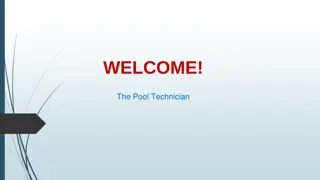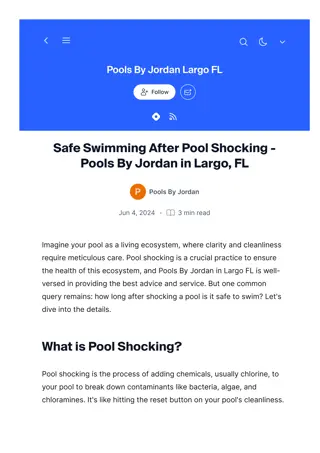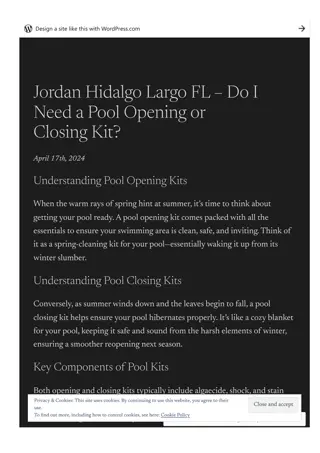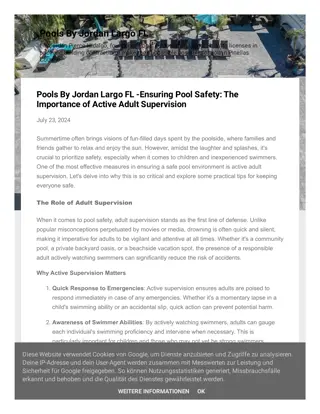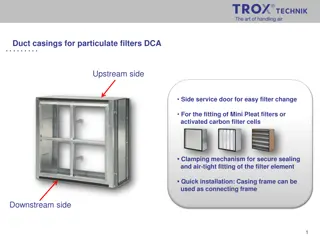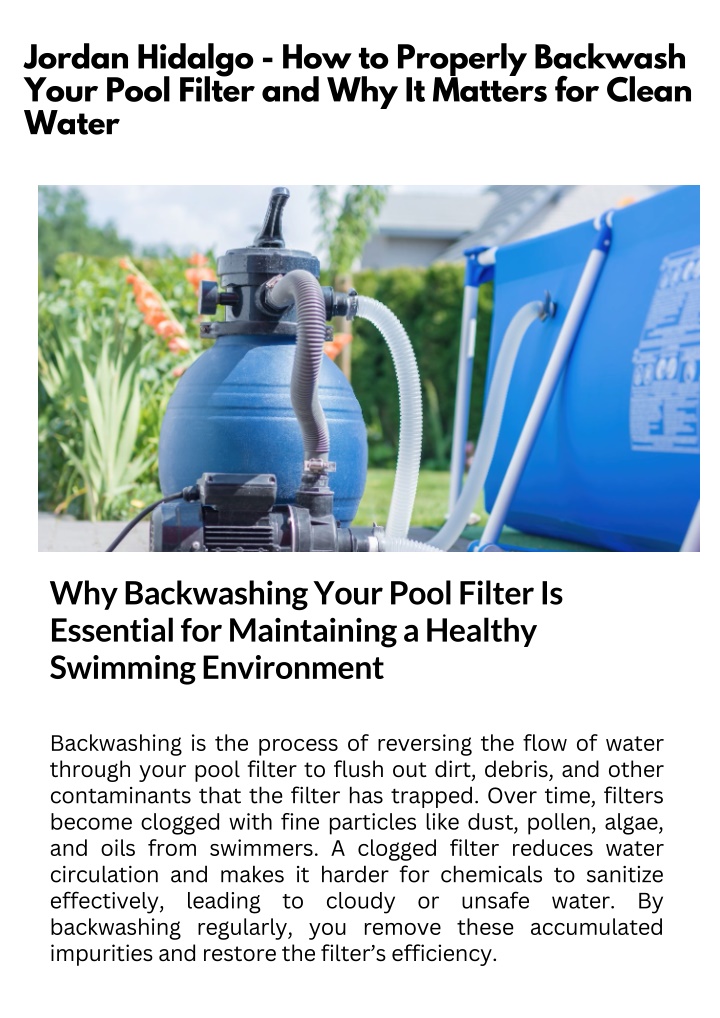
Jordan Hidalgo - How to Properly Backwash Your Pool Filter and Why It Matters fo
Backwashing is the process of reversing the flow of water through your pool filter to flush out dirt, debris, and other contaminants that the filter has trapped. Over time, filters become clogged with fine particles like dust, pollen, algae, and oils
Download Presentation

Please find below an Image/Link to download the presentation.
The content on the website is provided AS IS for your information and personal use only. It may not be sold, licensed, or shared on other websites without obtaining consent from the author. If you encounter any issues during the download, it is possible that the publisher has removed the file from their server.
You are allowed to download the files provided on this website for personal or commercial use, subject to the condition that they are used lawfully. All files are the property of their respective owners.
The content on the website is provided AS IS for your information and personal use only. It may not be sold, licensed, or shared on other websites without obtaining consent from the author.
E N D
Presentation Transcript
Jordan Hidalgo - How to Properly Backwash Your Pool Filter and Why It Matters for Clean Water Why Backwashing Your Pool Filter Is Essential for Maintaining a Healthy Swimming Environment Backwashing is the process of reversing the flow of water through your pool filter to flush out dirt, debris, and other contaminants that the filter has trapped. Over time, filters become clogged with fine particles like dust, pollen, algae, and oils from swimmers. A clogged filter reduces water circulation and makes it harder for chemicals to sanitize effectively, leading to cloudy or unsafe water. By backwashing regularly, you remove these accumulated impurities and restore the filter s efficiency.
Recognizing the Signs That Indicate Its Time to Backwash the Pool Filterr Pool Filter the Right Way Knowing when to backwash is just as important as knowing how. One of the most common indicators is a rise in filter pressure. Every pool filter comes with a pressure gauge that helps monitor performance. When the reading is 8 10 pounds per square inch (psi) higher than the clean starting pressure, it s time to backwash. Other signs include cloudy water, sluggish water flow, or weak return jets. If you notice debris circulating back into the pool, it may also be a clue that the filter needs cleaning. Step-by-Step Guide on How to Backwash Your Pool Filter the Right Way Backwashing is a straightforward process, but following the correct steps ensures you get the best results without damaging your equipment. First, turn off the pump to prevent water damage to the system. Next, set the multiport valve to the Backwash position. Turn the pump back on and allow it to run for two to three minutes, or until the water in the sight glass runs clear. After backwashing, turn the pump off again and set the valve to Rinse. Run the pump for about a minute to resettle the filter media before returning it to the Filter setting. Finally, restart the pump and check pressure levels.
Differences Between Sand, Cartridge, and D.E. Filters When It Comes to Backwashing Not all pool filters are the same, and the backwashing process depends on the type you own. Sand filters and diatomaceous earth (D.E.) filters are designed for backwashing, making them relatively easy to clean without removing the filter media. Sand filters typically require backwashing every few weeks, while D.E. filters also need a recharge of D.E. powder after the process. Cartridge filters, however, cannot be backwashed. Instead, they must be removed and hosed down manually, which can take more time and effort. The Impact of Regular Backwashing on Pool Water Clarity and Safety When contaminants from building up inside your filter and circulating back into the pool. This directly improves water clarity by keeping fine particles and organic matter out of the water. More importantly, it allows chlorine and other sanitizers to work more effectively, reducing the risk of bacteria or algae growth. Swimmers benefit from cleaner, safer water that is free from cloudy appearances and irritants. Regular backwashing also reduces the strain on your pool pump and extends the lifespan of your filtration system. done consistently, backwashing prevents
Common Mistakes Pool Owners Make When Backwashing and How to Avoid Them While backwashing is simple, mistakes can lead to wasted water or damage to equipment. One common error is over-backwashing. Running the pump too long wastes water and may disturb the filter media, reducing efficiency. Another mistake is backwashing too frequently, which can shorten filter life and remove valuable filter sand or D.E. powder unnecessarily. Forgetting to switch the valve back to Filter mode after backwashing is another common oversight, which leaves your pool in bypass mode and allows unfiltered water to circulate. Water Conservation and Environmental Considerations When Backwashing Your Filter Because backwashing discharges water from your pool, it s important to consider water conservation and proper disposal. On average, each backwash can waste between 200 and 300 gallons of water. To minimize this, only backwash when necessary, based on pressure readings rather than a fixed schedule. If local regulations permit, consider reusing backwash water for irrigation, provided it does not contain high levels of chemicals harmful to plants. Being mindful of environmental impacts allows you to maintain a clean pool while reducing waste.
Establishing a Routine Backwashing Schedule as Part of Your Overall Pool Maintenance Plan Consistency is the key to successful pool care. While backwashing should be done as needed based on filter pressure, it should also be integrated into your overall maintenance plan. Regularly monitor filter pressure, check water clarity, and schedule filter inspections to ensure everything is working smoothly. Combine backwashing with other essential tasks like testing water chemistry, brushing pool walls, and skimming debris to keep your pool in peak condition. Jordan Hidalgo recommends logging your maintenance tasks so you can track performance and spot recurring issues. Why Proper Backwashing Protects Both Your Investment and Your Enjoyment of the Pool Your pool is more than just a place to swim it s an investment in your property and lifestyle. Neglecting tasks like backwashing not only compromises water quality but can also lead to costly repairs, from damaged filters to failing pumps. More importantly, cloudy or contaminated water makes swimming less enjoyable and potentially unsafe. By learning how to backwash properly and staying on top of this maintenance step, you ensure that your pool remains a clear, refreshing, and healthy retreat for years to come.



